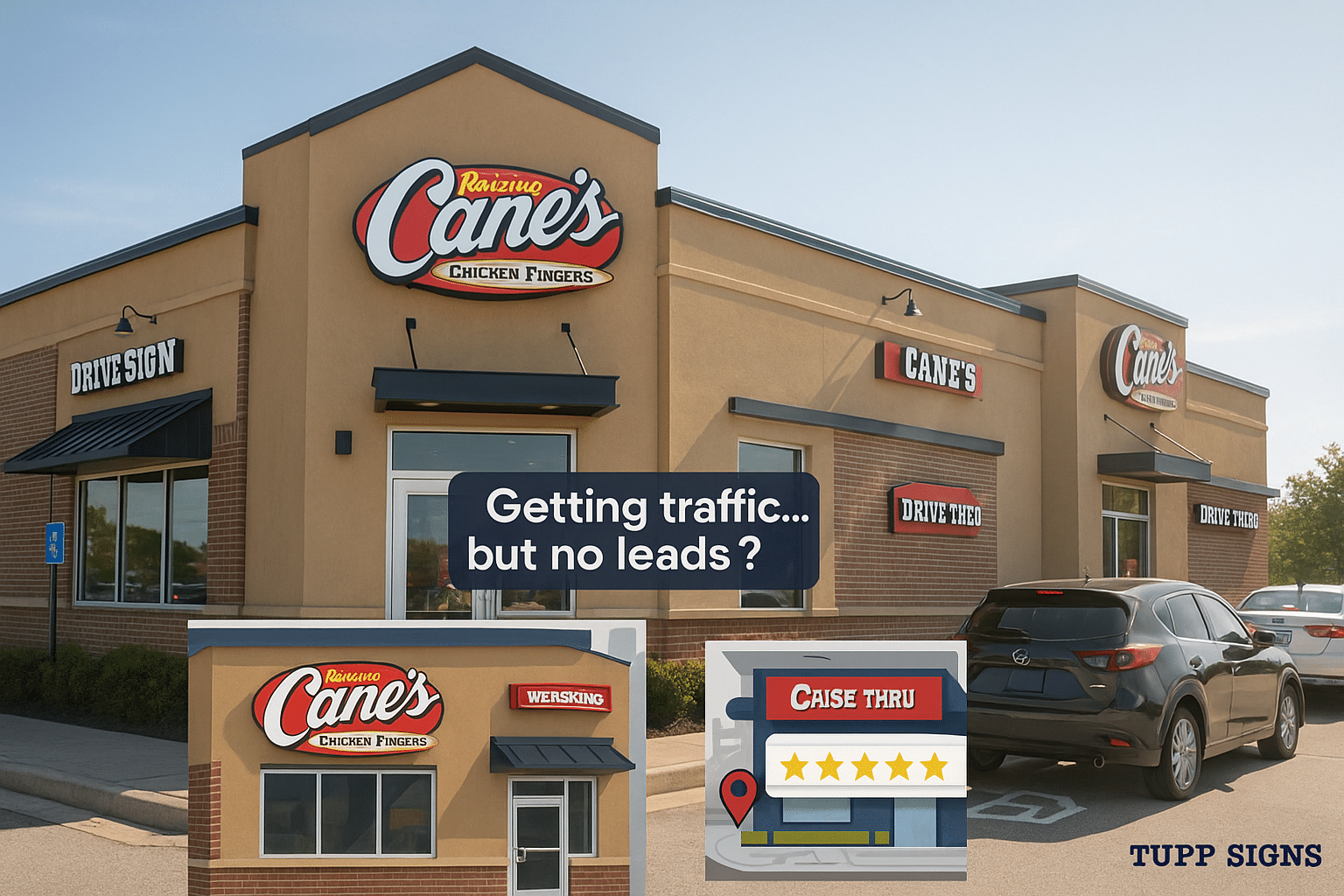A Dover Sign Code Case Study Every Multi-Faced Business Should Understand
Based on City of Dover Application #V-24-05 – Not a Tupp Signs Project
When Two Wall Signs Just Won’t Cut It
You’ve seen it before—your building has three customer-facing walls, two entry points, and a busy drive-thru lane. But the local code says you’re only allowed two wall signs. Suddenly, your branding, wayfinding, and visibility are compromised—not because of your design, but because of the rules.
That’s the exact dilemma Raising Cane’s faced when planning their Dover, Delaware location. Their solution? A variance application that made their case and earned approval for five wall signs.
At Tupp Signs, we weren’t involved in this project—but we help clients navigate similar situations every day. Here’s what happened, why it worked, and how your business can learn from it.
📌 Quick Summary
Raising Cane’s secured approval for five wall signs at their Dover, DE location—despite the two-sign limit. How? Through a well-prepared variance application that highlighted multiple entrances, drive-thru needs, and high-traffic visibility. If your business has similar challenges, Tupp Signs can help you build a legally strong case for expanded signage.
Dover’s Wall Sign Code: The Starting Point
According to City of Dover Zoning Ordinance Article 5 §4.7, most businesses are limited to two wall signs, typically placed on sides that:
- Face a public street, and
- Contain the main customer entrance
This works for standard storefronts—but becomes restrictive for:
- Corner-lot buildings
- Multi-entrance retail sites
- Restaurants with drive-thru circulation
That’s when businesses must request a variance—and prove that their situation justifies an exception.

The Raising Cane’s Variance: What the City Approved
In Application #V-24-05, Raising Cane’s requested an increase in wall signage from two to five signs for their proposed restaurant on North Dupont Highway.
Their justification? The building:
- Had multiple customer access points (front, side, and drive-thru)
- Sat on a high-traffic commercial corridor, requiring visibility from multiple angles
- Required brand consistency across all customer-facing sides, per corporate design standards
The City of Dover Board of Adjustment approved the request, citing:
- “Practical difficulties” due to lot and building configuration
- A need for “appropriate identification from each customer approach”
- Alignment with the “character of the surrounding area”
📎 This decision was documented in public file 17798.pdf. Tupp Signs was not involved in this case.
What Your Business Can Learn
Even if you’re not a national chain, the Raising Cane’s case proves that:
- Local codes can be flexible—when approached the right way
- Visibility matters just as much as compliance
- A multi-faceted business layout may require multi-face signage to serve customers properly
Here’s how to make your case:
Know Your Traffic Flow
Map where people arrive—on foot, in cars, or through drive-thru. Each approach may require its own signage touchpoint.
Document Your Needs
Provide renderings, elevations, and rationale for each additional sign. Focus on public safety, brand visibility, and customer experience.
Align With Aesthetics
Keep sign design, size, and lighting consistent with the building’s architecture and neighborhood standards.
Can You Request Extra Signs Too?
Yes—but you’ll need to:
- Apply for a zoning variance or conditional sign permit
- Justify your request with visuals, usage data, and legal code comparisons
- Prepare to coordinate with planning staff or a Board of Adjustment hearing
Each jurisdiction—whether Dover, Newark, or New Castle County—has its own criteria, but a clear and well-supported proposal gives you the best shot at approval.
How Tupp Signs Supports Complex Sign Strategies
While we weren’t involved in the Raising Cane’s case, we specialize in guiding business owners through:
- Code research and signage limits
- Custom wall sign system design (including for multi-frontage properties)
- Permit applications and variance documentation
- Fabrication and safe installation for code compliance
🔗 Read Our Permitting + Installation FAQs
Final Word: Don’t Settle for Invisible
If your business operates across multiple sides, has a drive-thru, or needs visibility from all angles—don’t assume two wall signs are enough. Like Raising Cane’s, you may have a case for more.
What matters is how you plan, document, and execute that strategy—and that’s where we come in.
🛠️ Tupp Signs: Your Multi-Face Wall Sign Strategy Partner
Multi-frontage buildings, drive-thrus, and corner lots all demand smarter sign strategies. Tupp Signs helps you stay visible and compliant with expert-level planning and execution.
- Wall Sign Code Research & Interpretation
- Multi-Faced Sign Layouts & Design
- Variance Preparation & Hearing Support
- Permit Filing, Fabrication, & Installation
📞 Call Tupp Signs at (302) 322-1600 or 📩 Request Your Wall Signage Review
Ready to Elevate Your Wall Signage the Smart, Legal Way?
📞 Call Tupp Signs at (302) 322-1600
📩 Request Your Wall Signage Review + Quote
❓ Frequently Asked Questions
Can I legally install more than two wall signs in Dover?
Yes, but you must apply for a zoning variance and demonstrate functional need.
What helped Raising Cane’s get approval?
Multiple customer access points, traffic flow requirements, and brand consistency were key factors.
How can Tupp Signs help with sign variances?
We handle research, design, documentation, and submissions to help businesses navigate complex signage challenges.


